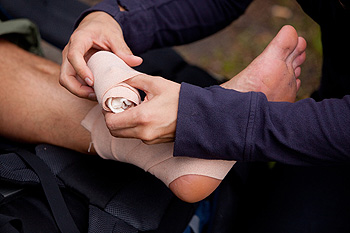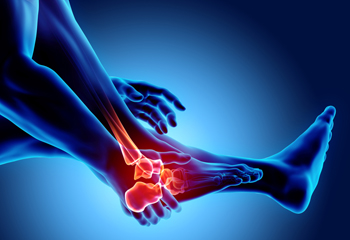Items filtered by date: March 2021
The Most Severe Kind of Ankle Sprain
 Ankle sprains occur when the foot is twisted beyond its usual range, and the ligaments that connect the bones become torn. Sprains are usually placed into three grades or categories. The first category, known as grade one, is a simple stretching or light tearing of the ligament, and there is minimal pain, swelling, or stiffness. A grade two sprain results from a partial tear of the ligament and leads to moderate swelling and bruising, as well as pain while walking. The most severe type of sprain, a grade three sprain, is a complete tear of the ligaments in the ankle. Swelling and bruising may be severe, and walking can be almost impossible. Grade three sprains may require a cast or brace, and surgery may be considered. Patients who have an ankle sprain should consult with a podiatrist who can make sure that there are no broken bones and provide treatment options.
Ankle sprains occur when the foot is twisted beyond its usual range, and the ligaments that connect the bones become torn. Sprains are usually placed into three grades or categories. The first category, known as grade one, is a simple stretching or light tearing of the ligament, and there is minimal pain, swelling, or stiffness. A grade two sprain results from a partial tear of the ligament and leads to moderate swelling and bruising, as well as pain while walking. The most severe type of sprain, a grade three sprain, is a complete tear of the ligaments in the ankle. Swelling and bruising may be severe, and walking can be almost impossible. Grade three sprains may require a cast or brace, and surgery may be considered. Patients who have an ankle sprain should consult with a podiatrist who can make sure that there are no broken bones and provide treatment options.
Ankle sprains are common but need immediate attention. If you need your feet checked, contact one of our podiatrists from Sayville Foot Care. Our doctors can provide the care you need to keep you pain-free and on your feet.
How Does an Ankle Sprain Occur?
Ankle sprains take place when the ligaments in your ankle are torn or stretched beyond their limits. There are multiple ways that the ankle can become injured, including twisting or rolling over onto your ankle, putting undue stress on it, or causing trauma to the ankle itself.
What Are the Symptoms?
- Mild to moderate bruising
- Limited mobility
- Swelling
- Discoloration of the skin (depending on severity)
Preventing a Sprain
- Wearing appropriate shoes for the occasion
- Stretching before exercises and sports
- Knowing your limits
Treatment of a Sprain
Treatment of a sprain depends on the severity. Many times, people are told to rest and remain off their feet completely, while others are given an air cast. If the sprain is very severe, surgery may be required.
If you have suffered an ankle sprain previously, you may want to consider additional support such as a brace and regular exercises to strengthen the ankle.
If you have any questions please feel free to contact our office located in Sayville, NY . We offer the newest diagnostic and treatment technologies for all your foot and ankle needs.
Finding Shoes for Speed Walking
While many specialty shoe stores emphasize their running shoes, you do not actually need to be a seasoned runner, or even a runner at all, to wear running shoes. Those who prefer to walk for exercise, and especially those who like to speed walk, may find that their shoe needs are best met with running shoes. Running shoes are built to be stable and comfortable. You will also want to look for shoes that are flexible and have adequate cushioning. Shoes that match your gait are also suggested. You can have your gait assessed at some shoe stores, or by a podiatrist. For more information about finding the right shoes for all of your physical fitness needs, please consult with a podiatrist.
For more information about walking shoes versus running shoes, consult with one of our podiatrists from Sayville Foot Care. Our doctors can measure your feet to determine what your needs are and help you find an appropriate pair of footwear.
Foot Health: The Differences between Walking & Running Shoes
There are great ways to stay in shape: running and walking are two great exercises to a healthy lifestyle. It is important to know that running shoes and walking shoes are not interchangeable. There is a key difference on how the feet hit the ground when someone is running or walking. This is why one should be aware that a shoe is designed differently for each activity.
You may be asking yourself what the real differences are between walking and running shoes and the answers may shock you.
Differences
Walking doesn’t involve as much stress or impact on the feet as running does. However, this doesn’t mean that you should be any less prepared. When you’re walking, you land on your heels and have your foot roll forward. This rolling motion requires additional support to the feet.
Flexibility – Walking shoes are designed to have soft, flexible soles. This allows the walker to push off easily with each step.
If you have any questions, please feel free to contact our office located in Sayville, NY . We offer the newest diagnostic and treatment technologies for all your foot care needs.
Causes and a Possible Solution for Ingrown Toenails
 An ingrown toenail can be quite painful and uncomfortable. It is a foot condition defined as a toenail that grows into the sides of the nail bed. This can occur for a variety of reasons including genetics, trimming the toenails incorrectly, or from an injury to the affected toe. Additionally, this condition may also arise due to wearing shoes that do not have adequate room for the toes to move freely in. A common symptom is extreme tenderness surrounding the affected nail, and pus may drain from the area if it becomes infected. Many patients have found mild relief when the foot is frequently soaked in warm water, and this can be helpful in softening the skin to gently lift the corners of the nail. If you have developed an ingrown toenail it is suggested that you seek professional advice from a podiatrist who can effectively treat this condition.
An ingrown toenail can be quite painful and uncomfortable. It is a foot condition defined as a toenail that grows into the sides of the nail bed. This can occur for a variety of reasons including genetics, trimming the toenails incorrectly, or from an injury to the affected toe. Additionally, this condition may also arise due to wearing shoes that do not have adequate room for the toes to move freely in. A common symptom is extreme tenderness surrounding the affected nail, and pus may drain from the area if it becomes infected. Many patients have found mild relief when the foot is frequently soaked in warm water, and this can be helpful in softening the skin to gently lift the corners of the nail. If you have developed an ingrown toenail it is suggested that you seek professional advice from a podiatrist who can effectively treat this condition.
Ingrown toenails can become painful if they are not treated properly. For more information about ingrown toenails, contact one of our podiatrists of Sayville Foot Care. Our doctors can provide the care you need to keep you pain-free and on your feet.
Ingrown Toenails
Ingrown toenails occur when a toenail grows sideways into the bed of the nail, causing pain, swelling, and possibly infection.
Causes
- Bacterial infections
- Improper nail cutting such as cutting it too short or not straight across
- Trauma to the toe, such as stubbing, which causes the nail to grow back irregularly
- Ill-fitting shoes that bunch the toes too close together
- Genetic predisposition
Prevention
Because ingrown toenails are not something found outside of shoe-wearing cultures, going barefoot as often as possible will decrease the likeliness of developing ingrown toenails. Wearing proper fitting shoes and using proper cutting techniques will also help decrease your risk of developing ingrown toenails.
Treatment
Ingrown toenails are a very treatable foot condition. In minor cases, soaking the affected area in salt or antibacterial soaps will not only help with the ingrown nail itself, but also help prevent any infections from occurring. In more severe cases, surgery is an option. In either case, speaking to your podiatrist about this condition will help you get a better understanding of specific treatment options that are right for you.
If you have any questions please feel free to contact our office located in Sayville, NY . We offer the newest diagnostic and treatment technologies for all your foot and ankle needs.
What Is Juvenile Idiopathic Arthritis?
Juvenile idiopathic arthritis (JIA) is the most common type of arthritis in children and adolescents. This condition can cause inflammation and joint pain in any joint in the body, including those in the feet and ankles. These symptoms can make it difficult to walk, as joints become stiff, swollen, and tender. The child may become easily tired, and it can become harder to complete activities of daily living. JIA is an autoimmune disease and its causes are currently unknown. If your child has JIA that affects their feet or ankles, a podiatrist can help manage the foot and ankle symptoms associated with this disease.
Arthritis can be a difficult condition to live with. If you are seeking treatment, contact one of our podiatrists from Sayville Foot Care. Our doctors can provide the care you need to keep you pain-free and on your feet.
Arthritic Foot Care
Arthritis is a joint disorder that involves the inflammation of different joints in your body, such as those in your feet. Arthritis is often caused by a degenerative joint disease and causes mild to severe pain in all affected areas. In addition to this, swelling and stiffness in the affected joints can also be a common symptom of arthritis.
In many cases, wearing ill-fitting shoes can worsen the effects and pain of arthritis. Wearing shoes that have a lower heel and extra room can help your feet feel more comfortable. In cases of rheumatoid arthritis, the arch in your foot may become problematic. Buying shoes with proper arch support that contour to your feet can help immensely.
Alleviating Arthritic Pain
- Exercises that stretch the foot can prevent further pain and injury and increase mobility
- Most of the pain can be alleviated with anti-inflammatory drugs, heat, and topical medications
- Massages can help temporarily alleviate pain.
It is best to see your doctor for the treatment that is right for your needs and symptoms. Conditions vary, and a podiatrist can help you determine the right method of care for your feet.
If you have any questions, please feel free to contact our office located in Sayville, NY . We offer the newest diagnostic tools and technology to treat your foot and ankle needs.
Plantar Warts Can Be Treated!
Types of Achilles Tendon Injuries
 The Achilles tendon is a thick band connecting the calf muscle to the heel bone on the back of the ankle. One common injury, Achilles tendonitis, is the result of the tendon becoming inflamed near its connection to the heel bone. This injury is often a result of overuse. Achilles tendinosis occurs when the tendon degenerates, often as a result of not treating Achilles tendonitis. One of the most severe Achilles tendon injuries is a rupture. This occurs when the fibers in the tendon are partially or completely torn. This requires immediate medical attention. Most Achilles tendon injuries result in pain in the calf and heel while moving, and a rupture will produce a sudden sharp pain in the calf and heel. If you are noticing pain or stiffness in the area of your Achilles tendon, please consult with a podiatrist as soon as possible.
The Achilles tendon is a thick band connecting the calf muscle to the heel bone on the back of the ankle. One common injury, Achilles tendonitis, is the result of the tendon becoming inflamed near its connection to the heel bone. This injury is often a result of overuse. Achilles tendinosis occurs when the tendon degenerates, often as a result of not treating Achilles tendonitis. One of the most severe Achilles tendon injuries is a rupture. This occurs when the fibers in the tendon are partially or completely torn. This requires immediate medical attention. Most Achilles tendon injuries result in pain in the calf and heel while moving, and a rupture will produce a sudden sharp pain in the calf and heel. If you are noticing pain or stiffness in the area of your Achilles tendon, please consult with a podiatrist as soon as possible.
Achilles tendon injuries need immediate attention to avoid future complications. If you have any concerns, contact one of our podiatrists of Sayville Foot Care. Our doctors can provide the care you need to keep you pain-free and on your feet.
What Is the Achilles Tendon?
The Achilles tendon is a tendon that connects the lower leg muscles and calf to the heel of the foot. It is the strongest tendon in the human body and is essential for making movement possible. Because this tendon is such an integral part of the body, any injuries to it can create immense difficulties and should immediately be presented to a doctor.
What Are the Symptoms of an Achilles Tendon Injury?
There are various types of injuries that can affect the Achilles tendon. The two most common injuries are Achilles tendinitis and ruptures of the tendon.
Achilles Tendinitis Symptoms
- Inflammation
- Dull to severe pain
- Increased blood flow to the tendon
- Thickening of the tendon
Rupture Symptoms
- Extreme pain and swelling in the foot
- Total immobility
Treatment and Prevention
Achilles tendon injuries are diagnosed by a thorough physical evaluation, which can include an MRI. Treatment involves rest, physical therapy, and in some cases, surgery. However, various preventative measures can be taken to avoid these injuries, such as:
- Thorough stretching of the tendon before and after exercise
- Strengthening exercises like calf raises, squats, leg curls, leg extensions, leg raises, lunges, and leg presses
If you have any questions please feel free to contact our office located in Sayville, NY . We offer the newest diagnostic tools and technology to treat your foot and ankle needs.



